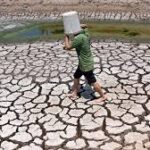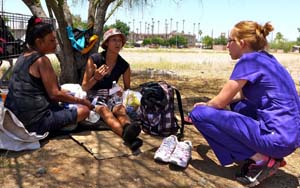 By Francisco García
By Francisco García
Pima County Health Department Medical Director
Spring in the desert brings warm days, cool nights and a kaleidoscope of color from our desert plants in bloom. We enjoy this time because — as desert dwellers — we know that just around the corner are the hot days of summer that begins in June with temperatures reaching and exceeding the century mark. It is important to remember that, just like people in the Northeast prepare for cold icy winters, we need to prepare for extreme summer temperatures.
The risk of exposure to extreme heat has serious consequences. That risk is particularly high in Arizona, where about 250 residents visit the emergency room for heat-related illness each year. An additional 25 people require emergency rescue for extreme heat exposure while hiking or doing other wilderness activities. Sadly, each year at least one person dies from extreme heat exposure before they make it to a hospital making the month of July one of the riskiest of the entire year.
The good news is we can prevent this. We all must take steps to protect ourselves and our families, beginning with knowing the signs and symptoms of excessive heat exposure.
There are consequences resulting from extended unprotected time in extreme heat. One would be sunburns. This is when our skin becomes very red and is sensitive to touch; the skin may blister and peel and can take several days to heal. Multiple exposures of this type increase the risk of skin cancer.
People experiencing heat exhaustion will be sweating heavily but have skin that is cool, moist, pale or flushed. This may be accompanied by a headache, nausea, dizziness and muscle weakness. However, people who are experiencing the effects of heat stroke will not be sweating even though they are very hot. Their skin will be red and dry and they will vomit and their heart rate will be very high.
Knowing the signs and symptoms is important, but more so is to respect the dangers of our hot desert temperatures and the risk of extreme heat exposure.
The following are my Top Ten Steps to Avoid Heat Exposure:
10. Avoid drinking alcohol when outdoors during the heat of the day. Drink water instead.
9. When outdoors, Limit your times between 10am – 4pm, drink water often and take breaks in a shady or cool area.
7. Wear a hat and light colored clothing to protect your arms and legs.
6. Plan outdoor exercise and activities for early morning or after 4 pm.
5. If cooling off at a local pool or waterpark, remember to drink plenty of water, use waterproof sunscreen and never leave kids unattended.
4. Use sunscreen with SPF of 30 or more and reapply as directed.
3. Check on neighbors, family and friends, especially the elderly.
2. Don’t leave kids or pets in the car – not even for a minute! Even in the shade the temperature can climb as much as 20 degrees in just 10 minutes.
1. Stay hydrated. Don’t wait until you’re thirsty.
I invite you to enjoy the beautiful Sonoran desert we inhabit with your family and to do so safely by taking some basic steps to protect against heat-related illness. Stay cool!















More Stories
Immigration and Street Releases
PACC at 142% capacity for dogs, in desperate need of adopters and fosters
A Difficult Question
Ready, Set, Rec
A Difficult Question – Sensible Cremations and Funerals
Proud Parents – Anna and Ben